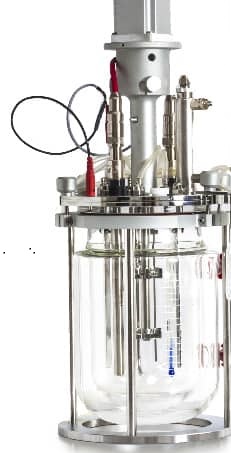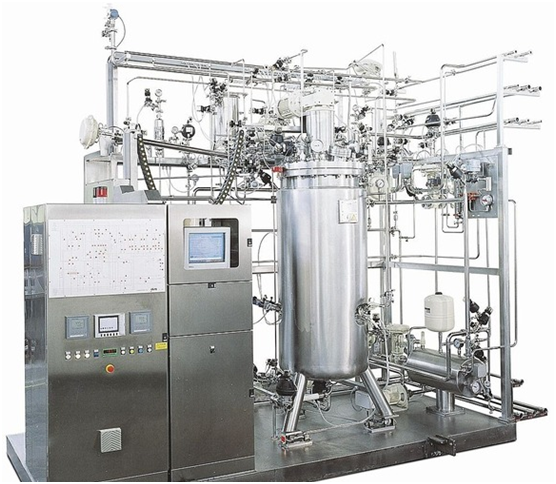Fed-batch fermentation is defined as the liquid fermentation process in which growth nutrients are periodically added in the fermentation medium during fermentation. The process is akin to batch fermentation process except that small concentrations of nutrients are added at the beginning of the process, and there is a continuous addition of nutrients during the process in small amounts.
In fed-batch fermentation, there is usually a predetermined or controlled addition of nutrients into the bioreactor at certain times of fermenter operations; and the process allows a temporal variation in the supply of growth nutrients to the culture. Fed-batch fermentation resembles batch fermentation and continuous fermentation systems but they all show variations in their mode of operations.
Fed-batch fermentations are most suited for the production of compounds produced by organisms that exhibit slow growth. This system of fermentation is also useful when the microbial biomass or product yield is highest at low substrate concentrations. Fed-batch fermentations can also be used when the product formation is dependent on a specific nutrient composition such as a carbon to nitrogen ratio.
Fed-batch fermentations allow the operators to adjust the nutrient inflow into the vessel in such a way that it matches the current physiological state of the microbial cell; and it is widely used in most fermentation industries. They are suitable for the manufacture or production of recombinant proteins, baker’s yeasts, enzymes, antibiotics, amino acids, organic acids, growth hormones, vinegar, antibiotics and amylase.
With fed-batch fermentation, the high concentration of microorganisms and possible feedback inhibition (catabolite repression) of the process could be controlled and reduced respectively. There is an increased production of bio-products in fed-batch fermentations since the exponential and stationary phase of growth is usually lengthened.
A fed-batch fermentation is useful in achieving high concentration of products as a result of high concentration of cells for a relative large span of time; and it is the best option for some systems in which the nutrients or any other substrates are only sparingly soluble or are too toxic to add the whole requirement for a batch process at the start of the fermentation process. Fed-batch fermentation like batch fermentation process has advantages and disadvantages.
MERITS OF FED-BATCH FERMENTATION
- There is usually an increased opportunity for optimizing the environmental conditions of the organisms in line with their phases of growth.
- There is a higher yield of the product. And this is attributed to the well-defined cultivation period during which time no cells is added or removed.
- The fed-batch fermentation system is suitable for mutating microorganisms and those at risk of contamination since the process can be operated in a stationary state.
DEMERITS OF FED-BATCH FERMENTATION
- In fed-batch fermentation, a specific growth rate cannot be maintained.
- The dynamic process of control carried out in fed-batch fermentation systems makes the process to be capital intensive.
- There is usually a lower productivity levels experienced in this system of fermentation due to the time it takes to fill, sterilize, clean and empty the vessel.
References
Bader F.G (1992). Evolution in fermentation facility design from antibiotics to recombinant proteins in Harnessing Biotechnology for the 21st century (eds. Ladisch, M.R. and Bose, A.) American Chemical Society, Washington DC. Pp. 228–231.
Nduka Okafor (2007). Modern industrial microbiology and biotechnology. First edition. Science Publishers, New Hampshire, USA.
Das H.K (2008). Textbook of Biotechnology. Third edition. Wiley-India ltd., New Delhi, India.
Latha C.D.S and Rao D.B (2007). Microbial Biotechnology. First edition. Discovery Publishing House (DPH), Darya Ganj, New Delhi, India.
Nester E.W, Anderson D.G, Roberts C.E and Nester M.T (2009). Microbiology: A Human Perspective. Sixth edition. McGraw-Hill Companies, Inc, New York, USA.
Steele D.B and Stowers M.D (1991). Techniques for the Selection of Industrially Important Microorganisms. Annual Review of Microbiology, 45:89-106.
Pelczar M.J Jr, Chan E.C.S, Krieg N.R (1993). Microbiology: Concepts and Applications. McGraw-Hill, USA.
Prescott L.M., Harley J.P and Klein D.A (2005). Microbiology. 6th ed. McGraw Hill Publishers, USA.
Steele D.B and Stowers M.D (1991). Techniques for the Selection of Industrially Important Microorganisms. Annual Review of Microbiology, 45:89-106.
Summers W.C (2000). History of microbiology. In Encyclopedia of microbiology, vol. 2, J. Lederberg, editor, 677–97. San Diego: Academic Press.
Talaro, Kathleen P (2005). Foundations in Microbiology. 5th edition. McGraw-Hill Companies Inc., New York, USA. Thakur I.S (2010). Industrial Biotechnology: Problems and Remedies. First edition. I.K. International Pvt. Ltd. New Delhi, India.
Discover more from #1 Microbiology Resource Hub
Subscribe to get the latest posts to your email.



